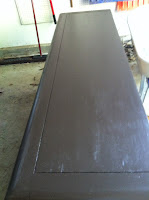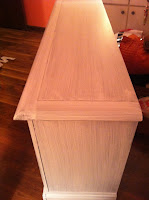We first needed to paint the room as it would be difficult to paint after the shelving was up and the white walls were starting to nag at me. Color please!
It took about three hours to paint the whole room "Rainy Afternoon". I wanted something that looked relaxing and also had a "study" feel. I took the whiskey barrel in the room as my inspiration and wanted to make the rest of the room have an older/worn feel.
We then measured our walls, floor to ceiling, side wall to window, and determined the measurements for our shelves and sides. We decided we didn't want to go completely to the ceiling, which was 8ft as that would require us to build the bookshelves while in the room otherwise we wouldn't be able to sit them up, also we wanted to give the wood room to expand. We also left a few inches off between the window and the shelf.
We went to Home Depot (b/c it's closer) and looked at the framing wood. The framing wood was fine for our purposes because we wanted a beat up worn look. We wanted the depth of our shelves to be 10" so we picked wood already at that width. We were able to make the shelves out of cut 10ft boards, the sides out of cut 8ft boards and the tops and bottoms of the shelves out of a cut 16ft board. They were all 2 inch wide boards.
When picking your wood look for interesting pieces that have a lot of knots or indents; however be cautious of ones with cracks and that are out of whack. You want the boards to be as straight as possible with as little warping.
We had the worker at Home Depot cut the wood to the lengths we needed. It saves times and if you don't have the tools at home it helps. Also if you don't have a large vehicle to transport the lengths this is a good idea.
We cut the shelves to 38", the sides to 7' 10" (realized later this needed to be shorter, but we took care of it at home) and the top and bottom boards to 42".
We wanted two bookshelves so we had 6 shelves for each, a top and a bottom for each and two sides each.
We also picked up 3 1/2 inch wood screws, and 2 inches L brackets, stain, and screws for the L brackets. (more in-depth material list below).
Once home I pulled out the sawhorses and started beating the boards up with a hammer and then stained all the pieces. This was a pretty quick process. Just follow the directions on the can. We realized at this point that our side shelves needed to be two inches shorter because of the top and bottom pieces, so Kyle pulled out the miter saw and took off the excess.
Once everything was dry I laid out the bookshelves for an idea of how they would be constructed. We realized the shelves did not get cut at exactly the right length so we needed to take a little of the top and bottom pieces so we didn't have awkward gaps.
There was a little trial and error in putting these together, but we found the easiest way was to measure the side boards first and mark where the shelves should sit. We determined we wanted them to be roughly 15" apart. We only ended up needing five shelves for each bookshelf. Measure on both side boards. We then screwed the shelves into one side board using three screws a board.
Have a good heavy duty electric drill. We had difficulties because the darn thing kept dying and we had to wait for it to charge.
Flip your bookshelf over on the side board that the shelves are already screwed into. Your shelves will be pointing into the air. Put your second side board on top of that. Line it up with your measurements. Then screw that side of the shelves into that side board, once again with three screws each shelf. We then screwed on the bottom and top boards.
Sit the shelf up and make sure everything looks even. Use a level to check your shelves. You may need to do some adjusting.
To add extra stability we added in L brackets on the side of each shelf. Just screw them in.
If you don't get this all right on the first try, don't fret. We had a heck of a time with the first shelf, getting it all even and getting rid of gaps. The first time we sat it up our shelves were all really crooked. But once we did get it all figured out, the second one went much quicker.
Once it was together, we had to man-handle that thing into the house. What a workout!
We got it into the room and had to lay it on its front and then lift it into the spot, otherwise we hit the ceiling. Once in we used 4 L brackets and screwed it into the wall, specifically into studs. If you don't it want be stable or safe.
I noticed once we had the shelves up I had missed a little staining on the sides, so I'll have to do some touching up.
Eventually I'd like to add a window seat in between and maybe an additional shelf above the window. All of this cost us under $150; that's both bookshelves. Good luck finding that deal anywhere else, or the pride of knowing you did it yourself!
Materials
Framing wood
-Decide your measurements to determine the best lengths. Boards 10 inches deep and 2 wide is good for a bookshelf.
Wood screws
- 3 1/2" #10x to screw all the wood pieces together
- 3/4" #6 wood screws to put L brackets on shelf
- 1 1/4" #6 wood screws to screw L brackets into studs
Stud Finder
L Brackets/corner braces
You can use a countersink if you choose. We left this step out.
Stain or Paint
Lambswool cloth or brush for stain or paintbrush/roller for paint
Hammer if you want a rough look
Electric Drill
Level








































